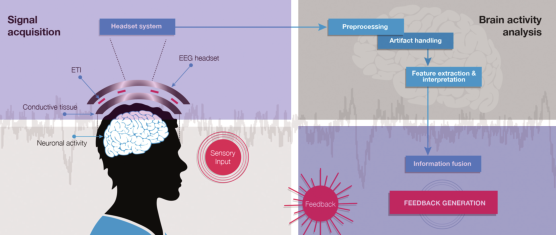V. Mihajlović, B. Grundlehner, R. Vullers, J. Penders

To take full advantage of noninvasive surface EEG recordings, EEG technology has to be advanced to a level that it can be used in daily life activities. Furthermore, users have to see it as an unobtrusive option to monitor and improve their health. To achieve this, EEG systems have to be transformed from stationary, wired, and cumbersome systems used mostly in clinical practice today, to intelligent wearable, wireless, convenient, and comfortable lifestyle solutions that provide high signal quality. A number of aspects have to be considered when developing intelligent EEG systems of the future, including personal traits and sensory inputs, brain signal generation and acquisition, brain signal analysis, and feedback generation. Within these aspects, the most critical areas which progress will to a large extent determine the evolution and deployment of wireless, wearable, lifestyle EEG systems, are the following ones:
- application driven design of EEG solutions;
- user driven development of EEG systems;
- standardizing and sharing of EEG data and contextual information;
- handling artifacts in daily life EEG.
Addressing these challenges in future research, design, and development endeavors would help in bringing EEG solutions to a more advanced level. With such devices at hand, users interested in promoting their quality of life and mental health, as well as the ones in need of cognitive monitoring solutions, would be able to enjoy the full potential of EEG monitoring.
Read full article at IEEE Xplore.
Tags: Biomedical monitoring, Brain models, Electrodes, Electroencephalography, Monitoring
